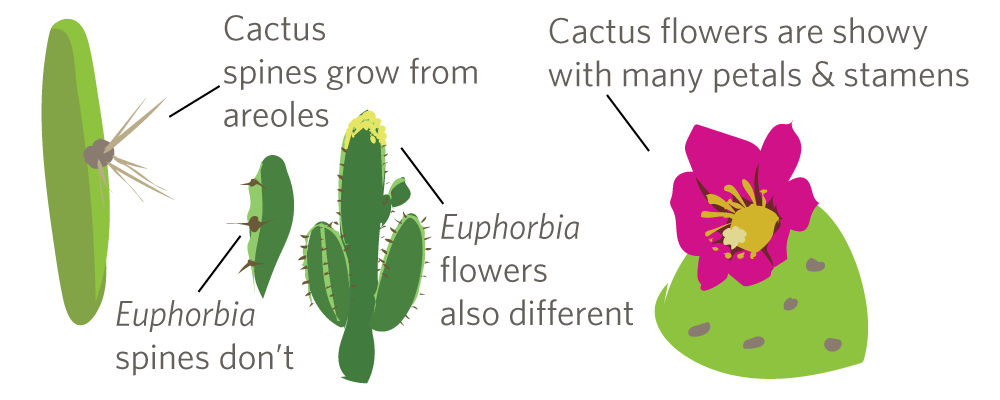Its Cactus Week on iNaturalist! Feb 7 - 13, 2016

That’s right, it’s not only critters on the Critter Calendar - this week we welcome our first plant group, the family Cactaceae, or cacti!
While there are exceptions (we’ll get to those later), the vast majority of cacti are succulent plants who have evolved to live in arid or semi-arid conditions. They’ve traded true leaves for spines and use their fleshy, water-storing stems to carry out photosynthesis, which dramatically reduces moisture loss. It’s these famous spines and how they grow that separate true cacti from similar-looking plants such as Aloes and Agaves (but some unrelated spiny Euphorbias mentioned below can look an awful lot like true cacti!). Look closely at the spines of a true cactus and you will see they grow from a structure (often wooly or hairy) on the stem called an areole. Areoles are believed to be condensed shoots or branches, and spines and flowers emerge from them (Euphorbia spines don’t grow from areole and also have milky sap). While cactus stems and leaves are some of the most modified and specialized in the plant kingdom, their flowers are almost unchanged from some of the very first ancestral flower. They are radial in shape and have many petals and stamens. Cactus flowers all rely on birds, insects, and bats as pollinators.


A familiar cactus is the Prickly Pear (Genus Opuntia), which has flat paddle-like stems and brightly-colored flowers and fruit. Both the young paddles and the fruit are commonly eaten by humans (if you've every had nopales!) and many animals such as tortoises and birds. Like all true cacti, Prickly Pears are native to the the new world but have been introduced to many other continents by humans.

The huge, iconic Saguaro Cactus is found naturally only in Sonoran Desert of the southwestern United States and northwestern Mexico. While they have been known to reach heights of over 70 feet, this is an exceptionally slow growing plant - an inch-tall cactus might be ten years old! Saguaros become homes for many animals, including many birds who nest in holes made by Gila woodpeckers. The Saguaro is a famous example of a bat pollinated cactus.

The only Cactaceae member found growing naturally outside of the new world is the Mistletoe Cactus, which is found in Africa, Sri Lanka and some islands in the Indian Ocean, as well as South America. It is an epiphyte with long dangling stems and white berries, somewhat resembling mistletoe.

Plants of the genus Pereskia are the only cacti who have persistent non-succulent leaves. However, look for the tell-tale areoles from which their spines emerge. These plants live in tropical regions of the new world and may resemble shrubs, vines, or trees. It is thought that the cactus ancestor resembled Pereskia.
If you think you see any of these this week, share your observations with us. We’ll be keeping track here. Happy Cactaceae hunting!





Comentarios
My least favorite part of cacti -- glochids! The spines don't bite nearly as hard as those little glochids... And when a glochid is in your skin, it's brutally hard to pull out:
http://www.life.illinois.edu/help/digitalflowers/Cactaceae/6.htm
Another point (I apologize for that): besides the Pereskias, there are two main groups of cacti - columnar and jointed. Columnar cacti include saguaros, barrel cacti, hedgehogs and the little globular cacti. Jointed cacti are chollas and prickly pears. And I agree with Sam about the glochids. By the way, only jointed cacti have glochids.
@sambiology and @stevejones - thanks both for extending the article. Very cool facts about both glochids and the columnar/jointed groupings. Personally, I didn't know about either of those cactoid-facts before!
Made the mistake of putting my backpack under a Prickly Pear a few years ago. When I stood up I got some of what I now know are glochids in my face. :/
brutal
Why I cannot longer add new observations to this project?
it should be automatically adding suitable obs - is there one obs in particular that you think should be in the project that isn't?
Ok, now it has been added. Thank you for reply.
Añade un comentario